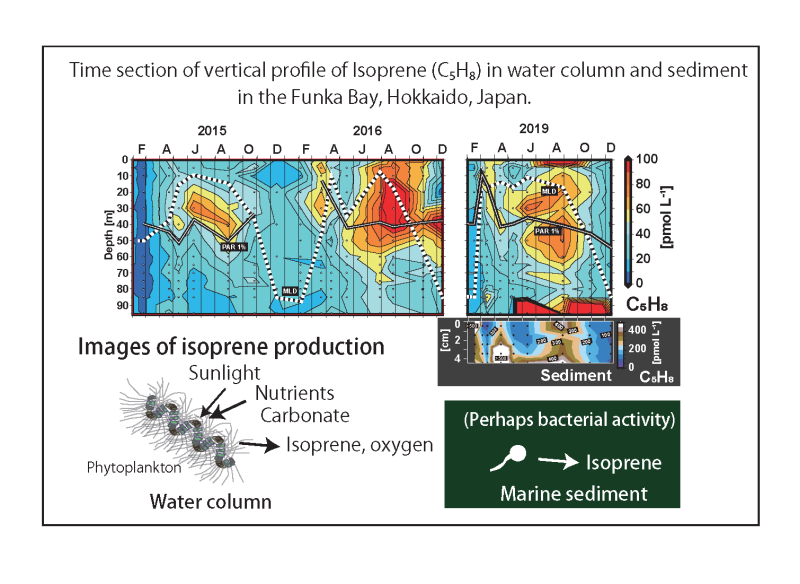
Isoprene production in the water column and sediment in Funka Bay, Hokkaido, Japan
ABSTRACT

We conducted shipboard observations in Funka Bay, Hokkaido, Japan, in 2015, 2016 and 2019 to observe temporal variations of isoprene (C5H8) concentration in water and sediment. We found increases in C5H8 concentrations below and within the euphotic zone, which were associated with chl-a peaks and changes in nutrient and dissolved oxygen (DO). We found a C5H8 peak in the subsurface layer within the euphotic zone at 20–30 m depth in May–June 2019 that coincided with a decrease in DO, suggesting that there was net oxygen consumption. We hypothesize that the rapid cycle of regenerated production in the subsurface layer in early summer resulted in C5H8 production (1.00–1.75 pmol (μg chl-a) d–1 at 30 m), decreased DO, relatively high chl-a levels, and nutrient depletion. We propose that C5H8 can be used as a new chemical parameter reflecting primary production, in addition to the common parameters of chlorophyll-a, nutrients, and oxygen. We attributed a C5H8 peak at the surface in May–June 2019 to photosynthetic production of C5H8 associated with new production, likely stimulated by the sporadic input of nutrients to the sea surface. In addition, this is the first study to report the presence of C5H8 in seafloor sediments. We found very high C5H8 concentrations in the sediment from the surface to 5 cm depth. We propose that C5H8 production and degradation by the bacterial community in coastal marine sediments are approximately in balance.
KEYWORDS
Keywords: phytoplankton, volatile organic compound (VOC), nutrient, coastal ocean, primary productionSupplementary Materials(file)
https://www.jstage.jst.go.jp/article/geochemj/56/5/56_GJ22013/_supplement/_download/56_GJ22013_1.pdf
- Published : 2022
- Released on J-STAGE : 2022/10/07
- Received : 2022/06/21
- Accepted : 2022/08/10
- DOI : https://doi.org/10.2343/geochemj.GJ22013
- J-STAGE URL : https://www.jstage.jst.go.jp/article/geochemj/56/5/56_GJ22013/_article/-char/en
- J-Online ISSN: 1880-5973
- Print ISSN : 0016-7002
- ISSN-L : 0016-7002
All Issues
- Vol.59, 2025
- Vol.58, 2024
- Vol.57, 2023
- Vol.56, 2022
- Vol.55, 2021
- Vol.54, 2020
- Vol.53, 2019
- Vol.52, 2018
- Vol.51, 2017
- Vol.50, 2016
- Vol.49, 2015
- Vol.48, 2014
- Vol.47, 2013
- Vol.46, 2012
- Vol.45, 2011
- Vol.44, 2010
- Vol.43, 2009
- Vol.42, 2008
- Vol.41, 2007
- Vol.40, 2006
- Vol.39, 2005
- Vol.38, 2004
- Vol.37, 2003
- Vol.36, 2002
- Vol.35, 2001
- Vol.34, 2000
- Vol.33, 1999
- Vol.32, 1998
- Vol.31, 1997
- Vol.30, 1996
- Vol.29, 1995
- Vol.28, 1994
- Vol.27, 1993
- Vol.26, 1992
- Vol.25, 1991
- Vol.24, 1990
- Vol.23, 1989
- Vol.22, 1988
- Vol.21, 1987
- Vol.20, 1986
- Vol.19, 1985-1986
- Vol.18, 1984
- Vol.17, 1983
- Vol.16, 1982
- Vol.15, 1981
- Vol.14, 1980
- Vol.13, 1979
- Vol.12, 1978
- Vol.11, 1977
- Vol.10, 1976
- Vol.9, 1975
- Vol.8, 1974
- Vol.7, 1973
- Vol.6, 1972-1973
- Vol.5, 1971
- Vol.4, 1970-1971
- Vol.3, 1969-1970
- Vol.2, 1968
- Vol.1, 1966-1967




